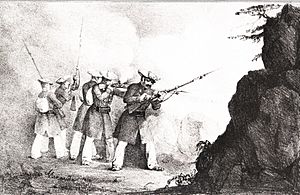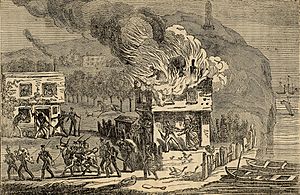Battle of Andoain facts for kids
Quick facts for kids Battle of Andoain |
|||||||
|---|---|---|---|---|---|---|---|
| Part of the First Carlist War | |||||||
 An illustration of Carlist soldiers during the war |
|||||||
|
|||||||
| Belligerents | |||||||
| Commanders and leaders | |||||||
| Strength | |||||||
| 3,000 | 7,000 | ||||||
| Casualties and losses | |||||||
| 100 killed and wounded | 750 killed and wounded 114 captured |
||||||
The Battle of Andoain (Basque: Andoaingo Gudua) was an important fight during the First Carlist War in Spain. It happened on September 14, 1837, near the village of Andoain in the Basque Country. This battle was fought between the Carlists and the Liberals, who were helped by the British Auxiliary Legion.
Liberal troops, led by General Leopoldo O'Donnell, had taken Andoain a few days earlier. They pushed the Carlist soldiers to the other side of the Oria River. For the next three days, both sides built defenses and had small fights. Then, the Carlists launched a big attack with heavy cannons and more soldiers, led by José Ignacio de Uranga.
The Liberal army was attacked from the side, and their lines broke apart. Only two British Auxiliary Legion groups and some of their Basque guides, called the Chapelgorris, were left to fight. They were eventually defeated and captured. Many British soldiers who surrendered were killed because local people were angry about buildings being burned by the Legion. This battle greatly weakened the British Auxiliary Legion. General O'Donnell and his remaining soldiers went back to Hernani, Gipuzkoa.
Contents
Why Did the Battle Happen?
After a victory at the battle of Oriamendi in March 1837, the Carlist army felt strong. Their leader, Carlos María Isidro de Borbón, planned a big move. He wanted his army to go through Aragon, Catalonia, and Valencia. The main goal was to get supplies and soldiers, and then attack Madrid. This plan was called the "Royal Expedition." It also aimed to stop the Liberals from blocking supplies to Carlist areas in the Basque provinces.
Meanwhile, the British Auxiliary Legion, which had lost at Oriamendi, started an attack along the coast. They took the town of Irun on May 17. As the Carlist troops moved towards Madrid, Liberal General O'Donnell left San Sebastián. He successfully attacked Hernani and Urnieta. The Carlists then moved back to the other side of the Oria and Leitzaran rivers, close to Andoain.
Getting Ready for Battle
On September 8, 1837, General O'Donnell gathered about 7,000 soldiers. They moved towards the Carlist lines between Hernani and Urnieta. The Liberals pushed the Carlists towards the Oria and Leizaran rivers, where the armies faced each other. O'Donnell set up his main camp in Andoain. This town was on the main road between San Sebastián and the Carlist stronghold of Tolosa.
The Carlist forces had about five groups from Guipuzcoa and local volunteers. They controlled the western side of the Oria River. Both sides started building defenses. O'Donnell's men rebuilt the town's fort, which the Carlists had destroyed. The Carlists built a six-foot-high wall with openings to shoot from, shaped like a horseshoe along the river. This wall made it hard for Liberals to cross the river.
The Carlists also had a hidden path to bring in more soldiers without being seen. The Liberals had some British cannons that sometimes hit the Carlists, causing injuries. Two British officers were hurt by snipers. British soldiers also burned many local barns, thinking the owners supported the Carlists. This made the local people very angry, and many joined the Carlist side to get revenge.
The Battle Begins

Before the main fight, Carlist soldiers from Navarre, led by General José Ignacio de Uranga, secretly arrived. These new soldiers increased the Carlist army to about 3,000 men. On the morning of September 14, the Carlists started firing five cannons at the Liberal forces in Andoain. The British cannons fired back.
Around 11 o'clock, Carlist foot soldiers came out of their defenses. They attacked the Liberal army from both sides. General Uranga wanted to trick the Liberals into moving their main force to their right. Then, he would attack their weaker middle and left sides. The British Rifle Brigade and two Scottish units, along with the Chapelgorris, were in the middle, watching the main bridge over the Oria River.
The Chapelgorris had to leave the bridge after heavy fighting. The Carlists attacked the eastern side of the river. A British officer, Colonel F. R. Clarke, gathered about 300 soldiers and attacked the bridge with bayonets, pushing the Carlists back. However, General O'Donnell had moved some of his experienced Spanish soldiers to another area, replacing them with new, untrained troops. These new soldiers ran away when the Carlists reached the eastern riverbank.
This allowed the Carlist army to attack the British from their left side. The British cannons had to retreat. Colonel Clarke's soldiers were trapped between the bridge and downtown Andoain, which the Carlists now controlled. Clarke was last seen at the bridge, where he was injured and captured. He was killed the next day. Other British officers were also killed.
The Scottish units and two companies of the Rifle Brigade were cut off. One company was almost completely wiped out, with only five survivors. The remaining soldiers tried to escape but were killed or died from exhaustion. The rest of Clarke's group hid in the local church. They had food and protection, but the 25 soldiers surrendered on September 16, hoping for mercy.
During the retreat, General O'Donnell's horse was killed, and he fell into a ditch. He was saved by a Scottish officer, Colonel James Arbuthnot. A group of British cavalry tried to help the trapped Scottish units and get back some rockets, but they were defeated by the Carlists. Thirteen British officers died at Andoain, some killed after surrendering. The main fighting lasted only about half an hour.
The Carlists were spread out after their victory, so they had to leave Urnieta. The Liberals briefly took it back, but O'Donnell decided it couldn't be held. He ordered his men to go back to Hernani. The Carlists captured many supplies, including bullets, firearms, rockets, tents, shoes, and food.
What Happened to British Prisoners?
There was an agreement called the Lord Eliot Convention that was supposed to stop the killing of prisoners. However, the Carlists often did not follow this rule for foreign soldiers. This was especially true after Carlos of Bourbon issued the "Durango decree", which said that all foreign "adventurers" fighting with the Liberals should be killed right away.
Most British soldiers who surrendered were killed by Carlist troops or by angry local people. The locals were furious because the British Auxiliary Legion had burned their homes and farms in the days before the battle. People shouted in Basque, "No mercy for the arsonists!" Spanish records say about 60 British soldiers were killed there. All captured British Auxiliary Legion members were forced to march to Tolosa, where they were also killed in the main square.
After the Battle
After the Battle of Andoain, the British Auxiliary Legion was no longer an effective fighting force. They had about 500 casualties, which was two-thirds of their strength. Some reports say around 150 officers and soldiers were killed after the battle. Because of these heavy losses, along with not being paid and a lack of supplies, the British Auxiliary Legion was officially disbanded on December 10, 1837.
The Liberal troops lost 320 killed and wounded, and 114 were captured. General Uranga's Carlist army had very few losses, with no more than 100 wounded. Don Carlos, the Carlist leader, celebrated the victory and created a special medal called the Cruz de Andoain (Andoain Cross) for the soldiers who fought in the battle.
The front lines in the north stayed mostly the same between Andoain and Urnieta for the rest of the war. The Carlists built new defenses there. The Liberal army launched a few small attacks in this area but only gained a little ground. The "Royal Expedition" eventually failed outside Madrid, and the main Carlist army retreated. Today, a historical reenactment of the battle is held every year in Andoain. It is the only event of its kind in the Basque Country related to the Carlist Wars.
See also
 In Spanish: Batalla de Andoáin para niños
In Spanish: Batalla de Andoáin para niños


